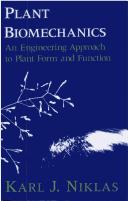| Listing 1 - 8 of 8 |
Sort by
|

ISBN: 0226586316 0226586308 Year: 1992 Publisher: Chicago London University of Chicago Press
Abstract | Keywords | Export | Availability | Bookmark
 Loading...
Loading...Choose an application
- Reference Manager
- EndNote
- RefWorks (Direct export to RefWorks)
Mécanique végétale --- Plant mechanics --- Plantenmechanica --- Plant mechanics. --- ANA Anatomy & Morphology --- anatomy --- biomechanics --- morphology --- plant mechanics
Book
ISBN: 0511693672 1108003605 Year: 2010 Publisher: Cambridge : Cambridge University Press,
Abstract | Keywords | Export | Availability | Bookmark
 Loading...
Loading...Choose an application
- Reference Manager
- EndNote
- RefWorks (Direct export to RefWorks)
Written in collaboration with his son Francis, Darwin builds on earlier investigations into climbing plants, orchids, insectivorous plants, flower variety, and the processes of fertilisation. This detailed study of many species from seed to mature plant further develops Darwin's work on adaptation and evolution, with the aim of collating the results of individual studies into common factors applicable to plants in general. Particular emphasis is given to analysis and investigation of the process here termed circumnutation, the movement of the stem of the plant in order to direct the head in certain directions. This is seen as very importance, with the conclusion that it is modification of this feature that has enabled plants to adapt and evolve so diversely. The authors also note similarities between plants and animals, such as sensitivity to touch and habit of action at certain times.
Plants --- Irritability and movements. --- Movements of plants --- Irritability --- Plant mechanics --- Pulvinus --- Movements
Book
ISBN: 0674059433 9780674059436 9780674048638 0674048636 Year: 2011 Publisher: Cambridge, Mass. Harvard University Press
Abstract | Keywords | Export | Availability | Bookmark
 Loading...
Loading...Choose an application
- Reference Manager
- EndNote
- RefWorks (Direct export to RefWorks)
Dov Koller (1925-2007) was working on this book when he passed away, and his daughter Daphne (a MacArthur fellow, mathematician and computer scientist at Stanford with her own book published in 2009 by MIT Press) sent the manuscript to MGF. This is the summary of a career and a field (plant biology), written in accessible language so that it can extend its reach beyond a small circle of specialists. The book is probably the most up-to-date account of movement in plants. It draws on examples across the spectrum of plant families, including mosses, ferns, conifers and flowering plants. The book begins with an explanation of how cellular motors work and then describes how cells manage to move organs. The bulk of the book explains how plants and plant organs (roots, stems, leaves, flowers) move in different environments and situations. Movement of roots, tubers, rhizomes and other plant parts underground is described in detail and much of this information is suprising because we normally don’t see it happening. Movement of stems and leaves toward the light is the research specialty of the author, and is explained in detail in two chapters. Effort is made to present information at the subcellular and cellular levels, including the roles of receptors, signaling pathways, hormones, and physiological responses leading to motor function. The adaptive significance of movements is discussed in each case.
Plants --- Tropisms. --- Tropic responses --- Growth (Plants) --- Movements of plants --- Irritability --- Plant mechanics --- Pulvinus --- Irritability and movements. --- Irritability and movements --- Movements

ISBN: 3540087761 9783540087762 Year: 1979 Volume: 7 Publisher: Berlin : Springer,
Abstract | Keywords | Export | Availability | Bookmark
 Loading...
Loading...Choose an application
- Reference Manager
- EndNote
- RefWorks (Direct export to RefWorks)
Plant physiology. Plant biophysics --- Plants --- Irritability and movements --- 581.1 --- 581.18 --- Movements of plants --- Irritability --- Plant mechanics --- Pulvinus --- Irritability and movements. --- Plant physiology --- Movements. Sensibility --- Movements --- 581.18 Movements. Sensibility --- 581.1 Plant physiology --- Plants - Irritability and movements
Book
ISBN: 2225469040 9782225469046 Year: 1977 Publisher: Paris: Masson,
Abstract | Keywords | Export | Availability | Bookmark
 Loading...
Loading...Choose an application
- Reference Manager
- EndNote
- RefWorks (Direct export to RefWorks)
Plants --- Plantes --- Irritability and movements --- Irritabilité et mouvements --- 581.18 --- Movements. Sensibility --- 581.18 Movements. Sensibility --- Irritabilité et mouvements --- Movements of plants --- Irritability --- Plant mechanics --- Pulvinus --- Movements --- Plants - Irritability and movements
Book
Year: 1970 Publisher: New York : Gordon and Breach Science Publishers,
Abstract | Keywords | Export | Availability | Bookmark
 Loading...
Loading...Choose an application
- Reference Manager
- EndNote
- RefWorks (Direct export to RefWorks)
Rhéologie. --- Rheology. --- Plantes comestibles. --- Plants, Edible. --- Propriétés mécaniques. --- Plant mechanics. --- Aliments d'origine animale. --- Food of animal origin. --- Aliments --- Food texture. --- Texture. --- Rhéologie. --- Propriétés mécaniques.
Book
ISBN: 0044453701 Year: 1990 Publisher: London Boston Wellington Unwin Hyman
Abstract | Keywords | Export | Availability | Bookmark
 Loading...
Loading...Choose an application
- Reference Manager
- EndNote
- RefWorks (Direct export to RefWorks)
581.184 --- Plants --- #WPLT:dd.prof.J.Vendrig --- Movements of plants --- Irritability --- Plant mechanics --- Pulvinus --- Tropisms. Directional responses. Geotropism. Phototropism. Thermotropism etc. --- Irritability and movements. --- Movements --- 581.184 Tropisms. Directional responses. Geotropism. Phototropism. Thermotropism etc. --- Irritability and movements --- Tropisms. Directional responses. Geotropism. Phototropism. Thermotropism etc
Book
ISBN: 3642190901 364219091X 9783642190902 Year: 2011 Publisher: Berlin: Springer,
Abstract | Keywords | Export | Availability | Bookmark
 Loading...
Loading...Choose an application
- Reference Manager
- EndNote
- RefWorks (Direct export to RefWorks)
Chemical reactions and interactions between molecules are commonly considered the basis of life, and thus the biochemical nature of cells and organisms is relatively well recognized. Research conducted in recent years, however, increasingly indicates that physical forces profoundly affect the functioning of life at all levels of its organization. To detect and to respond to such forces, plant cells and plants need to be structured mechanically. This volume focuses on mechanical aspects of plant life. It starts with a consideration of the mechanical integration of supracellular structures and mechanical properties of cellular building blocks to show how the structural integrity of plant cells is achieved and maintained during growth and development. The following chapters reveal how the functioning of integrated plant cells contributes to the mechanical integration of plants, and how the latter are able to detect physical stimuli and to reorganize their own cells in response to them. The mechanical aspects of plant responses to stresses are also presented. Finally, all these aspects are placed in an evolutionary context.
Plant cell interaction. --- Plant cell. --- Plant cellular control mechanisms. --- Plants. --- Botany --- Earth & Environmental Sciences --- Plant Physiology --- Plant mechanics. --- Plant cells and tissues. --- Plant tissues --- Flora --- Plant kingdom --- Plantae --- Vascular plants --- Vegetable kingdom --- Vegetation --- Wildlife --- Mechanical properties of plants --- Plants --- Mechanical properties --- Life sciences. --- Plant biochemistry. --- Plant ecology. --- Plant science. --- Botany. --- Plant anatomy. --- Plant development. --- Plant physiology. --- Life Sciences. --- Plant Physiology. --- Plant Anatomy/Development. --- Plant Biochemistry. --- Plant Sciences. --- Plant Ecology. --- Cells --- Plant anatomy --- Tissues --- Organisms --- Biomechanics --- Plant physiology --- Biochemistry. --- Ecology --- Botanical science --- Phytobiology --- Phytography --- Phytology --- Plant biology --- Plant science --- Biology --- Natural history --- Biological chemistry --- Chemical composition of organisms --- Physiological chemistry --- Chemistry --- Medical sciences --- Plant structure --- Structural botany --- Vegetable anatomy --- Anatomy --- Physiology --- Composition --- Structure --- Phytoecology --- Vegetation ecology --- Phytochemistry --- Plant biochemistry --- Plant chemistry --- Biochemistry --- Phytochemicals --- Plant biochemical genetics --- Development of plants --- Plant development --- Developmental biology --- Growth (Plants) --- Ontogeny --- Floristic botany --- Floristic ecology --- Life sciences --- Plant ecology
| Listing 1 - 8 of 8 |
Sort by
|

 Search
Search Feedback
Feedback About UniCat
About UniCat  Help
Help News
News